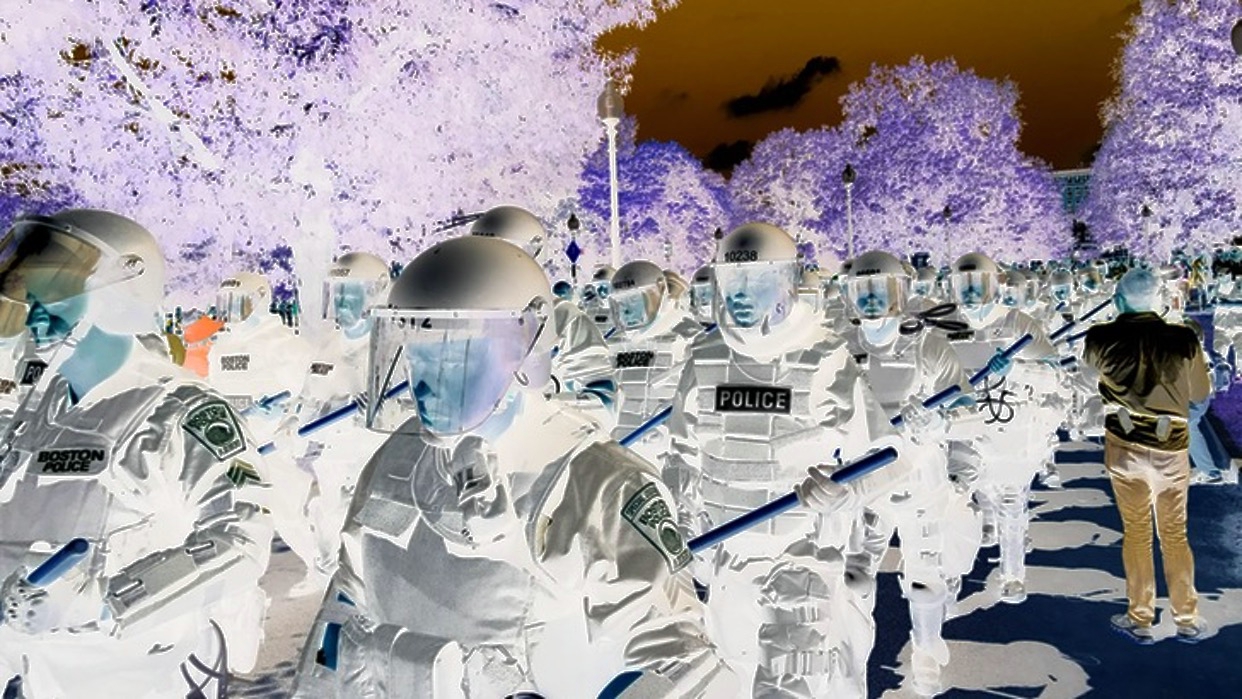Despite cries from advocates and experts, heavily armed SWAT teams are increasingly deployed to nonviolent protests in Mass
Even to observers who were previously jaded by images of police violence that have gone viral over the past several years, the scene in Newnan, Georgia, this April was shocking:
Beefy, heavily armed SWAT officers pointing assault rifles at a group of nonviolent protesters.
Screams and chaos as those same cops wade into the crowd to extract and arrest certain activists under an obscure state law forbidding the wearing of masks in public.
An array of armored vehicles and police aircraft buzzing around—much of it apparently provided gratis to local police through the Pentagon’s surplus equipment program.
It all started when anti-racist activists in Newnan, a suburb about 40 miles south of Atlanta, showed up to protest a rally being held by a couple dozen members of the neo-Nazi National Socialist Movement.
Captain Warren Campbell of the Coweta County Sheriff’s Office later told the Newnan Times-Herald that the aggressive tactics were needed because he and his fellow SWAT officers feared for their lives.
Referring to posts from far-right outfits that were later exposed as “fake news” sites, Campbell said, “Based on reports, we weren’t entirely sure if they were armed so it was a legitimate concern—especially being outnumbered.” According to figures released to the press, there were a total of 800 law enforcement officers on the scene that day—despite there being only about 700 protesters in total.
Such scenes have become all too familiar. As an article in a recent Police magazine special report notes: “In the last few years, law enforcement agencies in the United States have dealt with more civil unrest than they have seen in decades.” Yet oddly, nearly four years after Ferguson made police militarization a topic of national debate, heavily armed SWAT teams, with rifles and in armored vehicles, are still being deployed to non-violent protests. National surveys of police department tactical teams show the use of SWAT to respond to protests and “civil disorder” has increased significantly since the 1980s.
This increasingly common practice has made its impact felt in Massachusetts, where SWAT teams are routinely sent to protests in certain communities. And the trend has continued in spite of warnings from law enforcement leaders and civil liberties groups that SWAT should be deployed sparingly to such events.
Different needs, different teams
There has long been a distinction between SWAT and the type of police officers used for crowd-control duty. The modern SWAT team dates back to the 1960s, when law enforcement strategists began to realize that they needed to prepare responses for emergencies involving hostages, terrorists, or crazed gunmen. Crowd-control units have a longer history but grew to prominence during the same turbulent decade. According to Thor Eels, a veteran law enforcement leader and now executive director of the National Tactical Officers Association (NTOA), civil rights and anti-Vietnam protests were a major factor.
“In the 1960s and 1970s you had a lot of protests,” said Eels, “and because of that many US cities developed specialized crowd-control units.”
SWAT and crowd control have vastly different missions, standards, and training. Officers assigned to the latter, for example, receive special instruction in riot control maneuvers. According to a PowerPoint presentation currently used in such trainings by the Massachusetts State Police Public Order Platoon, these tactics go by such exotic names as the “Crossbow Line,” “Patriot Formation,” and that old chestnut, the “Flying Wedge.” (As previously reported by the DigBoston, the same PowerPoint also contained an image of an I-93 Black Lives Matter protester that had been digitally altered to ridicule her body shape. The image has since been removed).
Public disorder or crowd-control units are also distinguishable from SWAT officers by their uniforms—black color schemes are generally favored over camo—and their relative absence of heavy weaponry. All of which contributes to a vibe less about confrontation than cooperation. Shortly before the anti-racist protests in Boston Common last August, Daniel Linskey, a former Boston police superintendent in chief, summarized this approach: “There’s a need to take your helmet off and try the soft side first,” Linskey told the Boston Herald. Which can be accomplished, he added, by “engaging the crowd” and “keeping it friendly.” In other words, only when protests turn violent do departments typically dispense with softer tactics and bring in a “hard squad” outfitted with more body armor and preparations for battle.
In practice, some questioned whether the “hard squad” was deployed too quickly to the Common rally. Writing for the Intercept, reporter and observer Eoin Higgins (who has also written for DigBoston) noted a group of “mostly black men” as they “stood in front of police with their hands raised” in an act of passive resistance. “After a few tense minutes,” Higgins wrote, the police moved in and began hitting demonstrators and making arrests. [Ed. note: Several Dig reporters saw similar behavior and extensively documented multiple violent incidents.]

When SWAT becomes the default
“For a while they were well trained and equipped,” Eels, the National Tactical Officers Association executive director, said of the urban crowd-control units. “But that era passed and we went years without major rioting incidents.” Now, he added, with those units largely inactive, the job typically falls to SWAT “because they’re the only discretionary unit available to local police departments.”
A case in point comes from Berkshire County, where no local agency has sufficient resources to staff its own crowd-control team. Which is why every year the Berkshire County Special Response Team deploys its Bearcat and its officers to police the annual picnic held by Hells Angels at October Mountain State Forest in Lee. And why in March 2014, when hundreds of workers learned that they would lose their jobs after the abrupt closure of North Adams Regional Hospital, police called in the same regional SWAT team, whose members were tasked with forming a perimeter around the hospital complex to keep it secure.
Lack of dedicated crowd-control officers—sometimes referred to as a mobile field force—was later identified as one of the reasons police bungled their initial response to the Ferguson uprising. In September 2014, weeks after nonviolent marchers were met with SWAT officers bearing machine guns, then-head of the NTOA, Mark Lomax, addressed the Senate Committee on Homeland Security and Governmental Affairs: “With the exception of large metropolitan cities or jurisdictions that have had prior civil disorder events, most agencies have not invested in a mobile field force capability.”
In Massachusetts, the number of agencies that currently maintain their own crowd-control units remains small. Besides the State Police, they include Boston PD and the Northeastern Massachusetts Law Enforcement Council (NEMLEC), a mutual aid consortium comprised of officers from various departments and whose services are geographically flexible.
Even when agencies do have mobile field force or crowd-control units, they do not shy away from using their SWAT teams to police protests. In 2015 and 2016, state police deployed their Special Tactical Operations team a total of 20 times for either “protest support” or “event security,” according to state police annual reports released to this reporter under the public records law. Several years ago, NEMLEC came under fire over the use of their SWAT team for “event security” and dignitary protection.
In 2015, DigBoston spotlighted one absurd example: deploying 34 SWAT operators to police a 2012 appearance in Medford of his Holiness the Dalai Lama. Those embarrassing disclosures don’t seem to have stopped NEMLEC from sending SWAT to protests and other public gatherings. In 2017, according to documents reviewed by DigBoston, more than a third of the SWAT team’s deployments were for such events.
Combine the recent surge in activism and street protests in the US with the relative shortage of dedicated crowd-control resources and you get a situation where SWAT has become a routine response to public protest. In Mass, incidents over the past several years have reflected this trend.
- For a July 2013 protest outside the former Dominion Energy power plant in Somerset, more than 100 members of law enforcement had amassed to head off a nonviolent band of around 400 anti-coal activists. The police presence that a Fall River Herald News editorial later characterized as “excessive and expensive” included two armored vehicles and 17 camo-clad SWAT operators working with the Southeastern Massachusetts Law Enforcement Council (another mutual aid consortium). When asked about the riot gear, a protest organizer later told the press: “We were sorry that they felt the need to do that.”
- Coming just days after a protest in Dallas devolved into a major shooting incident, Cambridge police say they wanted to make sure protesters felt safe during a July 2016 Black Lives Matter demonstration. So, they dispatched members of the department’s Special Response Team, complete with—you guessed it!—a Bearcat armored vehicle. The vehicle’s presence at the rally drew immediate condemnation on social media. As Black Lives Matter spokeswoman Stephanie Guirand later told the Cambridge Day: “It was meant to assure people that police were prepared, so people could feel safe if there was a situation like Dallas. It had the opposite effect, obviously.”
- On May 1, 2017, around 250 immigrants and their supporters observed Day Without Immigrants by marching through downtown Lawrence. NEMLEC reports obtained by DigBoston show that two plainclothes state troopers marched alongside community activists, while NEMLEC also sent 16 of its SWAT officers to the scene, one of whom followed the march in a van while others waited nearby in case arrests had to be made. In the end there were no arrests. Yet the total number of law enforcement present for the march likely exceeded 100, making for a nearly Newnan-esque protester-to-police ratio of two and a half-to-one.
Nationally, the trends are the same. Results of a large survey of tactical policing carried out by the NTOA show that the number of police departments using their SWAT teams to respond to protests and “civil disorder” has increased by a third between 2009 and 2013. This represents a major shift over the past few decades. According to an earlier national survey, sponsored by the DOJ’s National Institute of Justice, the “vast, vast majority of teams never deployed at any civil disturbances” between 1986 and 1998.
A ‘possible chilling effect’
Adam Bates, a policy analyst at the libertarian Cato Institute’s Project on Criminal Justice, believes the police response to protesters goes to “the core, fundamental constitutional values of our society, the right to protest and to dissent.” In 2016, Bates warned an Associated Press reporter of a possible “chilling effect on those rights when you have this faceless kind of law enforcement that threatens to escalate situations where things can get out of hand.”
Cambridge PD’s Special Reaction Team, a SWAT outfit by all measures, is a fixture at local protests. In 2017, according to CPD spokesman Jeremy Warnick, all but one of the team’s 10 activations were to provide security and crowd control at events like the March on Google or the Caribbean Festival. In 2016, nine of 10 SRT activations were for protests, public gatherings, or “dignitary security.” Noting that the department had received nearly $1,200,000 in homeland security grants since 2013 to purchase—among other things—the aforementioned Bearcat, DigBoston wanted to know if crowd control was the most appropriate way to use a tactical team designed for emergency situations.
“That’s certainly a consideration when we go ahead with our deployments,” Warnick said in a phone interview. “The other part of it is the SRT’s presence is sometimes on request,” he added, noting that in 2017 the SRT deployed for two cases of “dignitary protection” following appeals from the US Secret Service.
As for that July 2016 Black Lives Matter protest, in an interview with the Cambridge Day, then-Vice Mayor Marc McGovern viewed the kerfuffle as “symbolic of how different groups would perceive an action differently.” While McGovern said he did not have a problem with the presence of an armored vehicle, he conceded, “People with a different experience will see it as a tank and be intimidated. It’s a symbol of our disconnect.”
‘Not where SWAT should be’
One Bay State police department trying a softer approach is Brookline, which has had a Special Response Team since 2012. Thanks to more than $100,000 in grants from the state’s Office of Emergency Management, Brookline SRT is well equipped to handle SWAT missions but is rarely used. While the SRT team has deployed at full strength on only five occasions since its inception, most recently a 2017 incident involving a barricaded suspect in Chelsea, it has never been deployed to a protest.
In an email, Brookline PD’s Lt. Philip Harrington wrote: “We understand the concern for the use of SRT officers at peaceful protests, but this is not our policy and we have never used the Team in that capacity.” Harrington’s department does have a bicycle unit that can assist with patrolling local demonstrations. Those officers, who wear standard police bicycle officer uniforms, receive training on how to handle crowds and large demonstrations.
On the other side of the coin, NEMLEC SWAT officers—the ones who deploy so regularly to police protests and provide security at crowded public events—are apparently receiving little training in crowd-control tactics. Training memos reviewed by the Dig show that NEMLEC SWAT training actually emphasizes use of force. Since July 2014, NEMLEC has set aside only one day for SWAT training dedicated to crowd control—in April 2015, shortly before team members were scheduled to provide enhanced security at the Boston Marathon. During that time, dozens of other training sessions consisted of having officers fire off rounds at a shooting range or busting down doors (and firing off more rounds) at a Fort Devens “shoot house.” Carlisle Chief of Police and NEMLEC president, John Fisher, did not respond to a call and email seeking comment from the Dig.
Proper maintenance of a civil disorder or crowd-control unit entails hours of specialized training each month for the assigned officers—which adds a further financial burden, especially for the more than 80 percent of law enforcement agencies in the US that have fewer than 50 officers. Faced with such costs, the NTOA’s Eels said, “A lot of agencies gamble and think they won’t need it.”
Eels’ organization, which represents more than 1,500 SWAT teams in North America, is trying to make a case for saner, softer approaches to protests by offering trainings to local and regional gatherings of police officers on how to respond to civil unrest.
“We’re … trying to get the word out that the traditional way of managing civil unrest is obsolete,” he said in a phone interview. “Until we change the mindset and get leaders and lawmakers to appreciate that there’s a difference between SWAT and crowd control,” he added, “you’re not going to see a change.
“Through leadership and command classes, we’re teaching that this is not where SWAT should be.”










